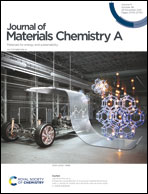Eco-compatible and highly efficient organic solar cells with an aggregation-controlled terpolymer strategy†
Abstract
Owing to the development of highly efficient donor and non-fullerene small-molecule acceptor materials, the power conversion efficiency (PCE) of organic solar cells (OSCs) has reached 17–19%. However, most of the highest-efficiency OSC devices still use a toxic halogen solvent in their device fabrication process, which dilutes their potential for scale-up production. In this study, we report a terpolymer strategy to develop donor polymers via an eco-friendly process by controlling the aggregation behavior. By introducing ethyl thiophene-3-carboxylate (ET) into the molecular structure of D18, the consequential solubility is improved significantly enough for dissolution in eco-compatible solvents, while preserving adequate aggregation. As a result, the newly developed terpolymers (PDs) can be processed with an eco-compatible solvent, o-xylene, and an OSC consisting of a PD with 10 mol% ET and Y6-BO exhibits an outstanding PCE of 15.5%, without any treatments such as additive addition, solvent vapor annealing, or thermal annealing. This excellent OSC performance is attributed to the superior charge carrier mobility, suppressed trap-assisted recombination, and substantial semi-crystalline behavior of the o-xylene processed PBET10:Y6-BO blend films. In addition, our o-xylene-based device shows a very good thermal stability of 90% retention of the initial PCE for 300 h in a 100 °C environment.



 Please wait while we load your content...
Please wait while we load your content...